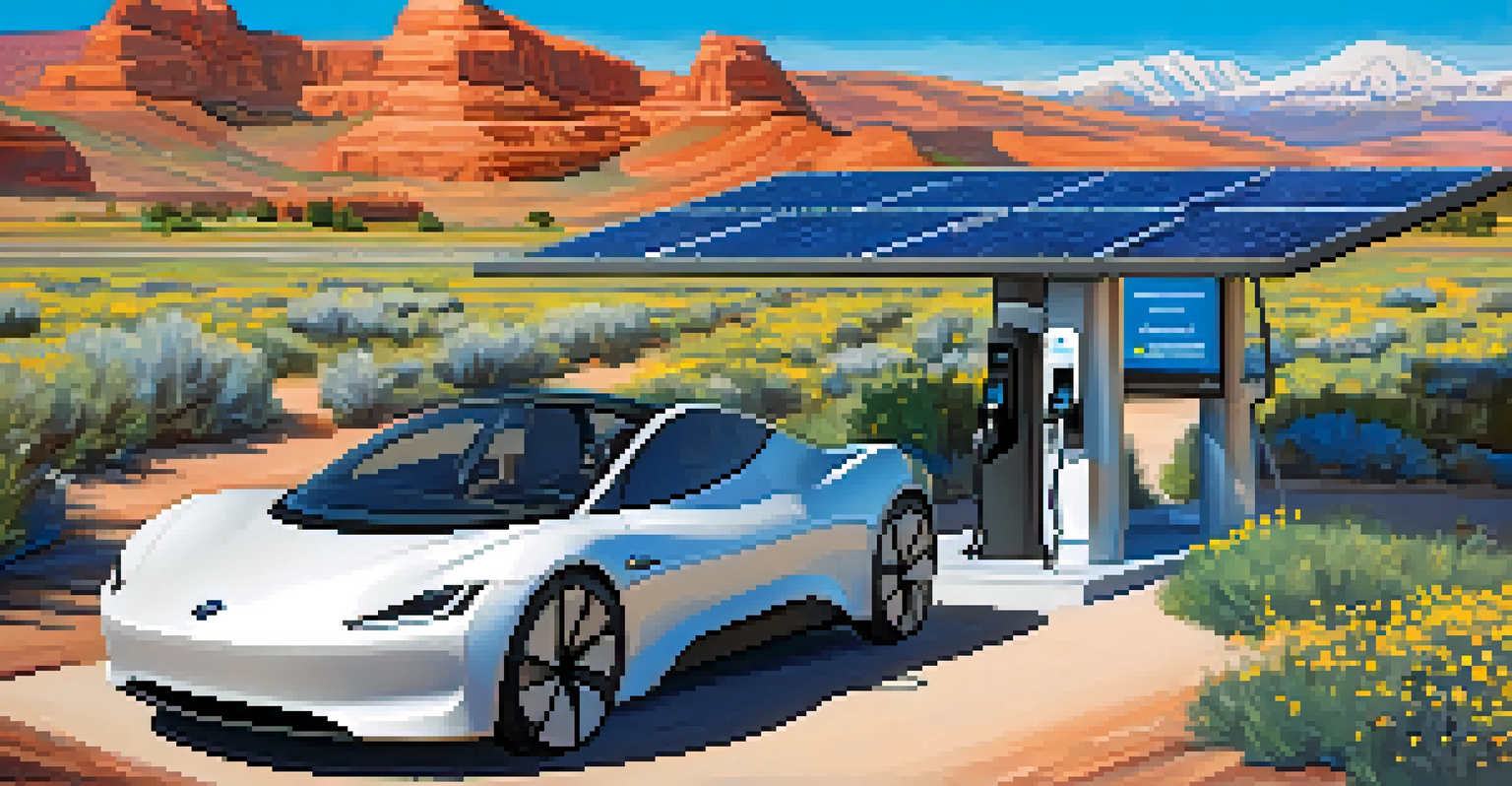The Future of Electric Vehicles in Utah's Transport System

The Current State of Electric Vehicles in Utah
Utah's electric vehicle (EV) market is slowly gaining traction, with an increasing number of residents recognizing the benefits of EVs. In 2022, Utah saw a significant rise in EV registrations, driven by incentives and a growing awareness of sustainability. The state government has been proactive in promoting cleaner transport options, which has led to a more robust EV infrastructure.
The future is electric, and the future is now.
Charging stations are popping up across urban and rural areas, alleviating range anxiety for potential EV owners. Notably, cities like Salt Lake City are leading the charge with numerous public charging options. The expansion of EV infrastructure is not just a convenience; it’s a crucial step toward a more sustainable transportation future.
Despite these advancements, challenges such as initial purchase costs and limited model availability still exist. However, as technology evolves and more manufacturers enter the market, these hurdles are expected to diminish. The future looks promising for electric vehicles in Utah, with both the state and its residents recognizing the long-term benefits.
Government Initiatives Supporting EV Adoption
Utah's government is keen on promoting electric vehicles through various initiatives and incentives. Programs like rebates for EV purchases and tax credits encourage residents to make the switch. Such financial incentives play a significant role in making EVs more accessible to a wider audience.

Moreover, state policies are increasingly focused on reducing greenhouse gas emissions, aligning with national climate goals. This commitment to sustainability has led to investments in renewable energy sources to power EV charging stations. As the grid becomes greener, the environmental benefits of driving electric will only improve.
Growing EV Market in Utah
Utah's electric vehicle market is expanding, driven by government incentives and a rising awareness of sustainability.
Local governments are also stepping up, launching campaigns to educate the public about the advantages of EVs. By fostering a culture of sustainability and awareness, these initiatives are positioning Utah as a leader in the electric vehicle revolution. The synergy between government action and public interest is vital for a successful transition to electric mobility.
Technological Advances in Electric Vehicles
Technological innovation is at the heart of the electric vehicle evolution. Battery technology, in particular, has seen remarkable improvements, resulting in longer ranges and shorter charging times. This progress is crucial for changing perceptions about the practicality of EVs in everyday life.
Sustainability is no longer about doing less harm. It’s about doing more good.
Additionally, advancements in smart technology are creating a more connected and user-friendly experience for drivers. Features like regenerative braking and autonomous driving capabilities are becoming standard in newer EV models. These innovations not only enhance performance but also contribute to safety and efficiency.
As technology continues to advance, the cost of production is expected to decrease, making EVs more affordable. This trend will likely lead to a wider array of models, catering to diverse consumer needs. The future of electric vehicles in Utah is not just about sustainability; it's also about convenience and accessibility.
The Role of Renewable Energy in EV Charging
As the electric vehicle market grows, so does the need for sustainable energy sources to power them. Utah is rich in renewable resources, particularly solar and wind energy, which can significantly contribute to charging infrastructure. By harnessing these resources, the environmental benefits of driving electric can be maximized.
Integrating renewable energy into the grid not only supports EV charging but also helps reduce reliance on fossil fuels. This transition aligns with broader climate goals and ensures that the shift to electric vehicles is truly sustainable. Many charging stations across Utah are already utilizing solar panels to provide clean energy for EVs.
Renewable Energy Fuels EV Future
The integration of renewable energy sources, like solar and wind, is essential for maximizing the environmental benefits of electric vehicles.
Moreover, this synergy between EVs and renewable energy can create local jobs and foster economic growth. As more businesses invest in green technologies, Utah's economy stands to benefit significantly. The combination of renewable energy and electric vehicles could pave the way for a cleaner, more sustainable future.
Public Perception and Community Engagement
Public perception plays a crucial role in the adoption of electric vehicles. Many Utah residents are becoming more environmentally conscious, driving interest in sustainable transport options. Community engagement initiatives, such as local EV fairs and informational workshops, are helping to demystify electric vehicles.
These events allow potential buyers to learn about the benefits of EVs firsthand, while also providing opportunities for test drives. Engaging the community fosters a sense of ownership and pride in participating in the transition to cleaner transportation. The more people understand the advantages of EVs, the more likely they are to consider making the switch.
Social media and local influencers also play a key role in shaping perceptions about electric vehicles. As more individuals share their positive experiences with EVs, it creates a ripple effect, encouraging others to explore their options. Building a supportive community around electric vehicles is essential for fostering a culture of sustainability in Utah.
The Economic Impact of Electric Vehicles
The rise of electric vehicles is poised to have a significant economic impact in Utah. With the increased demand for EVs, new job opportunities in manufacturing, sales, and maintenance are emerging. This shift not only supports the local economy but also fosters innovation within the automotive sector.
Additionally, investments in EV infrastructure, such as charging stations, will stimulate local businesses. Retailers and service providers can benefit from the increased traffic generated by EV owners seeking charging options. This creates a win-win situation where both the economy and the environment stand to gain.
Community Engagement Boosts Adoption
Public events and social media are crucial in shaping positive perceptions and encouraging Utah residents to consider electric vehicle options.
Moreover, as more residents adopt electric vehicles, the potential for long-term savings on fuel and maintenance becomes evident. This economic advantage can encourage even more individuals to consider making the switch. Ultimately, the transition to electric vehicles offers a pathway to a more sustainable and economically vibrant Utah.
Challenges and Considerations for the Future
While the future of electric vehicles in Utah is bright, there are challenges that need to be addressed. One major concern is the availability of charging infrastructure in rural areas, where access may not be as robust. Ensuring that all residents, regardless of location, have access to charging stations is crucial for widespread adoption.
Another consideration is the environmental impact of battery production and disposal. As electric vehicles become more popular, it’s essential to develop sustainable practices for battery recycling and reuse. Balancing the benefits of EVs with their environmental footprint will be key to maintaining public support.

Finally, ongoing education and awareness campaigns are necessary to keep the public informed about the evolving landscape of electric vehicles. As technology and infrastructure improve, continuous engagement will help alleviate concerns and misconceptions. By addressing these challenges head-on, Utah can pave the way for a sustainable and innovative transport system.